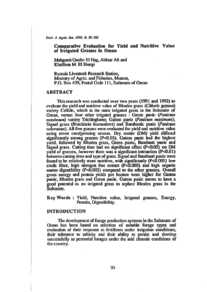وثيقة
Comparative evaluation for yield and nutritive value of irrigated grasses in Oman.
المعرف
DOI: 10.9755/ejfa.v8i1.5251
المصدر
Emirates Journal of Food and Agriculture. V. 8, 1, p. 93-102
المساهمون
Ali, Akhtar., مؤلف
El-Shargi, Khalfana M., مؤلف
الدولة
United Arab Emirates.
الناشر
United Arab Emirates University.
ميلادي
1996-09-01
اللغة
الأنجليزية
الموضوع
الملخص الإنجليزي
This research was conducted over two years (1991 and 1992) to evaluate the yield and nutritive value of Rhodes grass (Chloris gayatia) variety Collide, which is the main irrigated grass in the Sultanate of Oman, versus four other irrigated grasses: Green panic (Parriaun maximum) variety Trichloglume; Gattcn panic (Panicam maxhniim)\ Signal grass (Brachiaria teucitmims) and Bambastic panic (Pamcum calorantm). All five grasses were evaluated for yield and nutritive value using seven cuts/growing season. Dry matter (DM) yield differed significantly among grasses (P0.05) Gatton panic had the highest yield, followed by Rhodes grass, Green panic, Bambasii panic and Signal grass. Cutting lime had no significant effect (P0.05) on EM yield of grasses, however there was a significant interaction (P0.01) between cutting time and type of grass, Signal and Bambasti panic were found to be relatively more nutritive, with significantly (P0.005) low crude fiber, high nitrogen free extract (P0.005) and high organic matter digestibility (P0.005) compared to the other grasses. Overall gross energy and protein yields per hectare were higher for Gatton panic, Rhodes grass and Green panic. Gatton panic seems to have a good potential as an irrigated grass to replace Rhodes grass in the Sultanate.
ISSN
2079-052X
قالب العنصر
مقالات الدوريات

